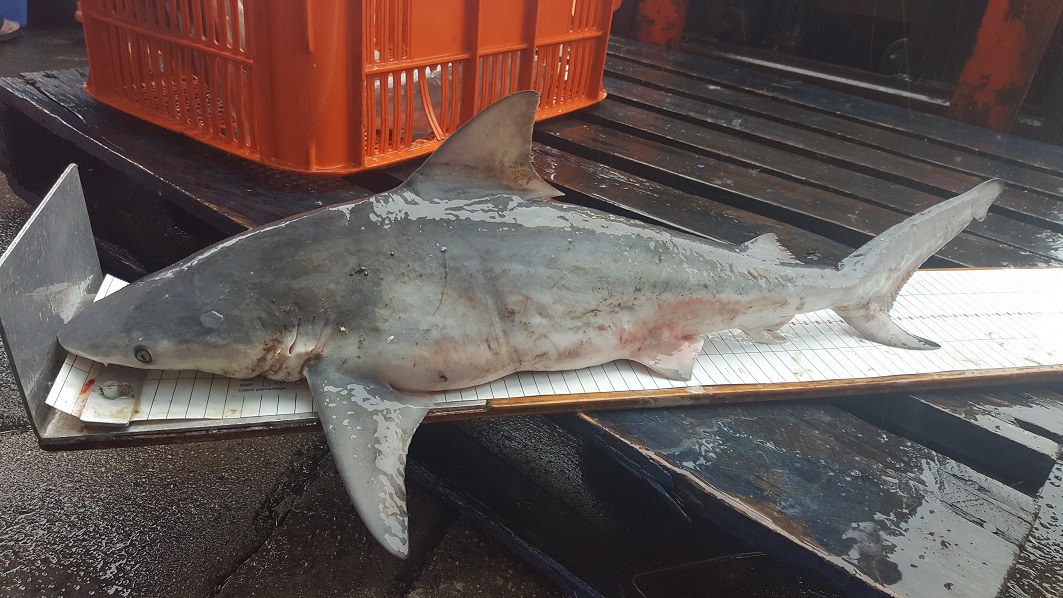Shark - net fishing monitoring
Shark management
Sharks typically show biological characteristics of slow growth, an older age at maturity and produce few young. These qualities mean that some shark species will have lower resilience to fishing pressures. Accordingly, it is important to monitor fishery activities that interact with shark stocks to ensure catches remain within sustainable levels.
Sharks show complexity in their use of Queensland’s coastal habitats. Some species remain in inshore habitats throughout their life, others utilise inshore areas only during discrete times such as migrating through, or aggregating in particular locations.
The variation in habitat use means each shark species can be impacted differently by inshore fisheries. Knowledge of what species are interacting with fishing operations is important for adequately assessing the impacts of a fishery on shark stocks.
Commercial catch monitoring
Fisheries Queensland monitors the commercial catch of sharks through commercial fishing logbooks and the automated integrated voice response (AIVR) system. These monitoring activities collect essential catch information.
Catch information, together with licensing requirements and management arrangements enable fishers to harvest at sustainable levels.
Information gaps continue to provide challenges for the future management of sharks in Queensland’s fisheries. For example, more accurate species information would improve the data used to establish the status of fish stocks.
Current catch data has low species resolution and the quantity and fate of shark species being returned to the water remains largely undocumented. Improving this data will assist in more accurately determining the catch of individual shark species.
Biological monitoring
As part of the Sustainable Fisheries Strategy 2017 - 2027, Fisheries Queensland is committed to collecting additional biological information on sharks to address key information gaps.
The Fisheries monitoring team are undertaking a shark monitoring program to address two broad objectives:
- Determine the species composition of the retained shark catch.
- Develop a profile of the non-retained shark catch.
Monitoring activities will focus on net catches in the east coast inshore fin fish fishery (ECIFFF) and the Gulf of Carpentaria inshore fin fish fishery (GOCIFFF).
Monitoring the retained catch
Monitoring staff will undertake year-round representative sampling of catches in ports, at processors or on-water. The sampling will describe the species composition of the retained catch.
Sampling will include the collection of photographic and genetic samples to assist with accurate species identification and data on the size, sex and maturity of the sampled catch.
Monitoring the non-retained catch
The non-retained catch is an important part of the shark catch. The non-retained catch refers to those animals that are not kept, i.e. animals that are returned to the water either alive or dead.
To improve our knowledge about this part of the catch, monitoring staff will undertake activities such as:
- surveying commercial net fishers to document the behavioural and economic drivers within the fishery. View 2018 phone survey results .
- at-sea sampling of the fishery to collect photographic and genetic samples and record important data on fate, size, sex and maturity.
What will the data be used for?
The purpose of the monitoring program is to improve our knowledge of the species being caught and the size, sex, maturity and fate characteristics of the catch.
The program will also document the reasons that fishers decide to keep or not keep sharks they catch. Collectively, this information will assist in establishing the status of shark stocks that interact with Queensland’s fisheries.
How to become involved
The monitoring team work closely with commercial fishers as well as seafood processors and retailers to collected biological information on sharks.
Thank you to all stakeholders who have generously assisted with the monitoring of sharks either through participating in the phone survey, by donating shark samples or by allowing Fisheries Queensland staff to sample their retained and non-retained shark catches.
We encourage all commercial net fishers to become actively involved in the monitoring program. Fishers can continue to help fill in information gaps about their fishery by allowing monitoring staff to collect samples and information from their catches

